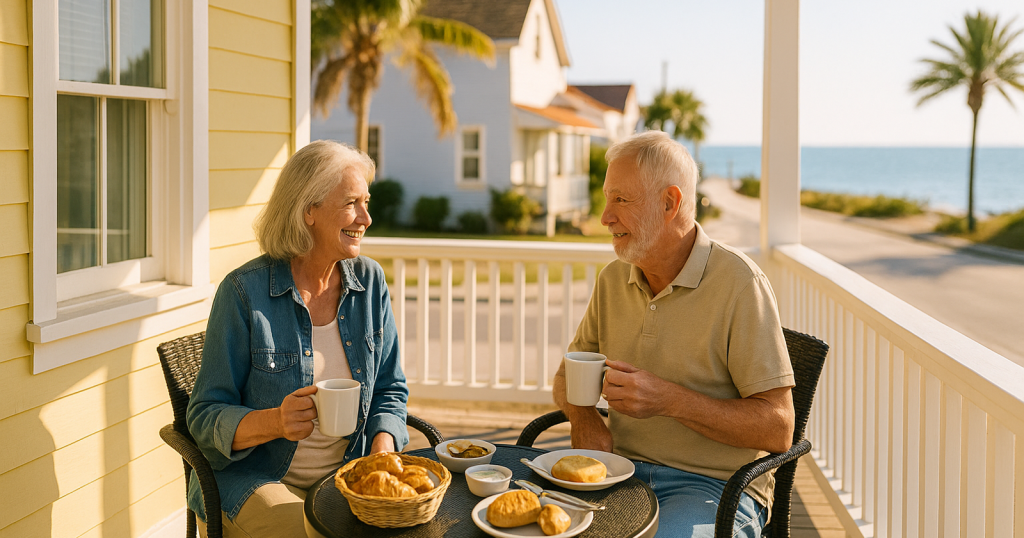There’s a specific fantasy that runs through American retirement planning, and it doesn’t involve yachts or European river cruises. It’s simpler: waking up somewhere affordable, walking to a dining room where someone else has already made coffee, and not having to choose between groceries and medication.
For working-class retirees living on Social Security averaging $1,976 monthly (as of January 2025), the phrase “meals included” isn’t an amenity—it’s a lifeline. These five places have figured out how to make retirement actually affordable, and yes, breakfast comes with the deal. Not because it’s fancy, but because it’s necessary.
1. Hot Springs Village, Arkansas—where your HOA fee covers more than you’d think
Spread across 26,000 acres of Ouachita Mountain foothills, Hot Springs Village operates on a model that makes accountants in expensive states weep. The monthly HOA fees (around $113 for improved lots) include access to nine golf courses, eleven lakes, and recreational amenities.
Here’s what matters for working-class retirees: the community attracts independent seniors who can afford to live on modest budgets. Total monthly overhead—including HOA fees, utilities, and property taxes—can run around $600-800 for homeowners without mortgages. That leaves room in a Social Security budget for actual living.
The Village isn’t trying to be Palm Beach. It’s trying to be a place where retired teachers and factory workers can fish in the morning and grab lunch at local eateries without checking their bank balance first.
2. Uniontown, Pennsylvania—the overlooked option an hour from Pittsburgh
Nobody puts Uniontown on glossy retirement brochures. That’s precisely why it works for people on fixed incomes. Average rent hovers around $656 monthly. Senior living communities cluster in this small town, many offering meal-inclusive packages starting around $1,500—total.
Pennsylvania doesn’t tax Social Security income, and several HUD-subsidized senior housing communities in the area provide meals as part of their programs. You pay 30% of your income toward rent and services. The rest, including congregate dining rooms with breakfast and lunch, comes through the subsidy.
This isn’t glamorous retirement. But it’s dignified, it’s affordable, and you’re an hour from Pittsburgh’s museums and hospitals when you need them. Sometimes that’s enough.
3. Sun City Center, Florida—the affordable Florida that actually exists
Florida retirement communities come in two flavors: wildly unaffordable and quietly manageable. Sun City Center is the latter. Positioned between Tampa and Sarasota, this 55+ community bills itself as one of West Central Florida’s most affordable active living options.
For those seeking independent living communities nearby with meal services, all-inclusive packages in the broader Florida market can start around $2,400 monthly—including three meals daily, housekeeping, activities, and transportation. No surprise bills for dinner. No wondering if you can afford to join the painting class.
The pitch isn’t luxury. It’s predictability. When you’re on Social Security, knowing exactly what you’ll spend matters more than marble countertops.
4. Lincoln, Nebraska—where the Midwest keeps its promises
Lincoln combines university town energy with cost-of-living numbers that make coastal residents assume there’s a typo. Average rent runs around $943. Multiple senior communities offer meal-inclusive independent living at rates working-class retirees can actually manage.
Nebraska doesn’t levy inheritance or estate taxes, which matters if you’re trying to leave anything to your kids. The University of Nebraska offers continuing education for seniors, often at reduced rates. And several communities include continental breakfast and communal dinners as standard amenities, not upcharges.
The trade-off? It’s Nebraska. Winter exists. But for retirees who’d rather stretch their dollars than spend them on palm trees, that’s not a dealbreaker—it’s the point.
5. Boise, Idaho—the surprise contender nobody expected
Boise keeps appearing on “best places to retire” lists, usually with a caveat about rising costs. But dig past the hype and you’ll find affordable senior living communities that haven’t priced out working-class retirees yet.
Several communities offer independent living with dining services starting around $2,500 monthly. MorningStar facilities include all-day dining, meaning breakfast, lunch, and dinner come with your monthly fee. Idaho’s cost of living remains below the national average, and the state doesn’t tax Social Security benefits.
You’re trading beach access for mountain views and a genuine four-season climate. But you’re gaining access to outdoor recreation, cultural amenities from Boise State University, and retirement communities designed around the reality of limited budgets rather than the fantasy of unlimited ones.
Final thoughts
The dream of retiring to a place where meals are included isn’t about laziness or luxury. It’s about the math finally working. When groceries, cooking, and meal planning disappear from the monthly budget and to-do list, suddenly Social Security goes further. Suddenly there’s money for the pharmacy and the grandkids’ birthdays.
These five places understand something expensive retirement destinations miss: working-class Americans aren’t looking for champagne breakfasts. They’re looking for reliable coffee, a decent egg scramble, and the dignity of not having to choose between eating well and keeping the lights on.
The “free breakfast” isn’t free, of course—it’s built into fees and budgets and careful planning. But it’s included, predictable, and one less thing to worry about. And for retirees who’ve spent decades worrying about money, that peace of mind might be worth more than ocean views.

